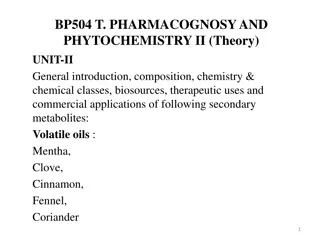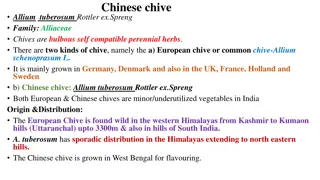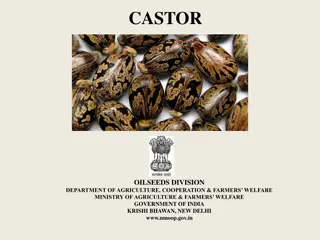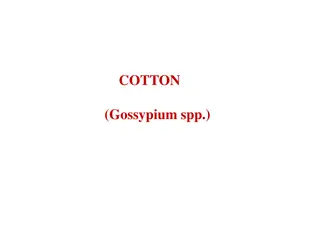Comprehensive Overview of Soybean Cultivation in India
Soybean cultivation in India, spearheaded by the Soybean Oilseeds Division under the Ministry of Agriculture & Farmers Welfare, Government of India, boasts a rich history tracing back to ancient China. The crop is known for its adaptability to diverse climates and soils, with specific sowing seasons and growth patterns detailed. Despite being a key source of protein, soybeans are primarily categorized as oilseeds, with significant global production statistics highlighting India's prominent role. The infographic showcases the national and global scenarios of soybean cultivation from 2013-2016, elucidating area, production, and yield trends, emphasizing India's considerable presence in the soybean market.
Download Presentation

Please find below an Image/Link to download the presentation.
The content on the website is provided AS IS for your information and personal use only. It may not be sold, licensed, or shared on other websites without obtaining consent from the author. Download presentation by click this link. If you encounter any issues during the download, it is possible that the publisher has removed the file from their server.
E N D
Presentation Transcript
SOYBEAN OILSEEDS DIVISION DEPARTMENT OF AGRICULTURE, COOPERATION & FARMERS WELFARE MINISTRY OF AGRICULTURE & FARMERS WELFARE GOVERNMENT OF INDIA KRISHI BHAWAN, NEW DELHI www.nmoop.gov.in 1
BOTANICAL DESCRIPTION Family :Leguminoceae sub-family :Papilionoideae :Fabaceae Common Name : Scientific Name : Glycine max-Linn Origin: Domestication of soybean has been traced to the eastern half of North China in the eleventh century B.C. or perhaps a bit earlier soybean production was localized in China until after the Chinese-Japanese war of 1894-95.
SEASON AND CLIMATE Two cropping seasons of soybean kharif and spring. It is self pollinated crop. In case of kharif season most common time of sowing is onset of monsoon or last week of June to first week of July while spring sowing is done between 15th of February and 15th of March. Soybean has been adopted under wide range of climate and soil with better performance under Vertisols with good organic content. The crop requires about 60-65 cm annual rainfall drought at flowering or just before flowering results in flower and pod drops, while rains during maturity impairs the grain quality of soybean harmful. 3
CROP DESCRIPTION Despite being rich source of protein, it is categorized as an oilseeds rather than a pulse crop. Oil contents varies from 15 to 21 % in soybean seeds. Crop generally reach a height of around 1 m (3.3 ft). Capable of transforming nearly 60-100 kg atmospheric nitrogen into 30-40 kg nitrogen in the soil. 4
GLOBAL SCENARIO OF SOYBEAN (2013-2016) Country Avg. Area (lakh ha) Avg. Production (lakh tonnes) 1010.74 Avg. Yield (Kg/ha) 324.01 3119 USA 310.22 918.00 2959 Brazil 194.30 558.35 2874 Argentina 68.33 120.83 1768 China 114.92 103.27 899 India* 32.00 87.45 2733 Paraguay 20.87 58.29 2794 Canada 17.64 35.35 2004 Ukraine 11.77 28.30 2405 Uruguay 17.38 22.35 1286 Russia 54.24 98.32 1813 Others 1164.84 3030.62 2602 World Source: FAO/USDA. *As per the estimates of DES, DAC&FW 5
NATIONAL SOYBEAN SCENARIO (2013-16) State Avg. Area (lakh ha) Avg. Avg. Yield (Kg/ha) Production (lakh tonnes) 54.99 31.14 9.76 2.56 2.12 3.56 103.27 MP Maharashtra 37.05 Rajasthan Telangana Karnataka Others All India 59.32 927 840 886 1058 880 993 899 11.02 2.42 2.41 3.58 114.92 6
AREA, PRODUCTION AND YIELD TRENDS OF SOYBEAN IN INDIA 14.00 12.00 10.00 8.00 Area in million ha Production in million tonnes 6.00 Yield in qtl/ha 4.00 2.00 0.00 1970-71 1980-81 1990-91 2000-01 2010-11 2015-16 7
POTENTIAL DISTRICTS (60) OF SOYBEAN State Potential district (>50,000 ha area) Madhya Pradesh (30) Ujjain, Sehore, Dewas, Dhar , Shajapur, Sagar, Vidisha, Harda, Indore , Rajgarh, Chhindwara, Betul, Mandsaur, Hoshangabad, Guna, Ratlam, Raisen, Bhopal, Narsingpur, Shivpuri, Seoni, Neemuch, Khandwa, Ashoknagar, Damoh, Tikamgarh, Jhabua, Khargone, Satna. Chhatarpur Maharashtra (20) Amravati, Nagpur, Latur, Buldhana, Yavatmal, Nanded, Washim, Hingoli, Akola, Wardha, Kolhapur, Chandrapur, Sangli, Parbhani, Nasik, Satara, Ahemdnagar, Jalna, Beed, Osmanabad Rajasthan (5) Jhalawar, Baran, Pratapgadh, Kota, Bundi Chhattisgarh (1) Rajnandgaon Karnataka(2) Belgaum, Bidar Telangana (2) Adilabad, Nizamabad 8
STATE WISE YIELD GAP UNDER FLDs (IN KHARIF) SAY (kg/ ha) FLD Kharif- 2013 (kg/ha) Yield Gap (%) Varieties used in FLD during Kharif 2013 State MP 831 1347 62 JS-95-60, JS-97-52, JS-93-05, MACS-1188, MACS-1281, NRC- 7, , NRC-37, NRC-86, JS-335, Maharashtra 1349 2213 64 MAUS-81, MAUS-61-2, MACS- 450, MACS-1188, MACS-1281, KDS-344, RKS-18, JS-335, Rajasthan 829 1469 77 RKS-45, JS-95-60, JS-335, JS- 93-05, 65 Mean 1003 1661 9
POPULAR VARIETIES OF SOYBEAN S.No. State Varieties 1 MP JS-95-60, JS-97-52, JS-93-05, JS-335, MACS-1188, MACS-1281, NRC-7, , NRC- 37, NRC-86 2 Maharashtra MAUS-81, 450,MACS-1188, MACS-1281, JS-335, KDS-344, RKS-18 MAUS-61-2, MACS- 3 Rajasthan RKS-45, JS-335, JS-93-05, JS-95-60 4 Karnataka MAUS-2, RKS-18, DSb-1, DSb-21, JS-93- 05, JS-335 5 Telangana JS-335 10
PACKAGE AND PRACTICES Moist alluvial / vertisols are best. Deep ploughing in summer to expose insect/pests to sunlight. Use of well de-composed FYM - 5-10 tonnes/ha. Recommended doses of fertilizers @ 20: 40: 40:30 Kg N: P: K: S / ha. Optimum sowing time is mid of June subject to availability of moisture/rainfall. Optimum seed rate of 75 Kg/ha for small seeded varieties and 100 Kg/ha for bold seeded varieties. Adoption of varietal cafeteria approach rather than monoculture for risk management. 11
PACKAGE AND PRACTICES (contd) Seed treatment with Rhizobium / PSB and Carbendazim/Thiram/Thiamethoxam. Application of pre-emergence weedicides followed by inter-culture operations. Adoption of Broad-Bed-Furrow/Ridge-Furrow System for effective water management. Inter-cropping of soybean with arhar for risk management. 12
PACKAGE AND PRACTICES (contd) Insect Pests: Use of resistant varieties. Stem-fly : JS 335, PK 262, NRC 12, MACS 124. Defoliators: NRC 7, NRC 37, JS 80-21, Pusa 16, Pusa 20, Pusa 24, PS 564, PK 472, Girdle Beetle : JS 71-05, Soybean Rust : JS 80-21, PK 1029, PK 1024, Indira Soya 9, Collar-Rot: PK 262, PK 416, PK 472, PK 1042, NRC 37, Myrothecium Leaf Spot: Bragg, JS 71-05, Bacterial Pustule: PK 416, PK 472, PS 564, Bragg, Yellow Mosaic : PK 416, PK 472, PS 564, PK 1024, PK 1029, PS 1042, PS 1092, SL 295. 13
PACKAGE AND PRACTICES (contd) For the control of Yellow Mosaic Virus (YMV) disease, spray of methyl dematon 25EC @ 0.8 l/ha or Thiomethoxam 25WG @ 100 g/ha is recommended for the control of vectors. One spray of microbial pesticides (Dipel /Biobit /Dispel) followed by spray of chemical insecticide after 15 days for the control of defoliators. In rust prone areas, prophylactic sprays of Hexaconazol, Propiconazol, Triadimefon @ 0.8 kg/ha is recommended. For the management of foliar diseases two sprays of Carbendazim or Thiophenate methyl @ 0.5 kg/ha at 35 and 50 days after sowings. 14
MSP Vs MARKETING PRICE State/MSP Avg. Price of November and December 2013 2014 2015 MSP (Rs. / qtl.) 2560 2560 2600 MP 3300 3025 3462 Maharashtra 3233 3126 3300 Rajasthan 3470 3138 3397 15
EXPORTS / DEMAND (Quantity in tonnes and value Rs. in crores) Products 2013-14 2014-15 Qty Value Qty Value De-oiled Cake 4235413 14438.95 1630461 5568.74 Soybean oil 457 5.27 463 4.36 Soya sauce 535 3.78 596 3.21 Soya milk 239 1.89 51 0.50 Total 4236644 14449.89 1631571.04 5576.81 16
NUTRITIVE VALUE chemical composition of soybean seed which includes about 20% oil and 40% protein. The soybean contain very little of starch (4.66-7%) and quite a lot of Hemicellulose and Pectins. Protein of soybean products characterized much quantity lysine (2.56), Tryptophan (0.52), Isoleucine, Valine and Threonine (1.54) however sulphuric amino acids are less than in protein of rape products. Number of Nutraceutical compounds such as Isoflavons, Tocopherol and lecithin has made it one of the most valuable agronomic crops in the world.17
RESEARCHABLE ISSUES Resistance varieties for Yellow Mosaic Virus. Short duration varieties for dry land areas Varieties with low linolenic fatty-acid to improve the shelf life of soybean oil. Varieties with less beany flavours and Lipoxygenase (enzyme) lacking varieties (Kyushu-III-Japan) for increasing domestic consumption of Protein Rich Soya Foods. Varieties with bold pods/seeds for use as vegetable. Technology for safe storage and transport of soybean seed without loss of seed viability. 18
ISSUES / ACTIONABLE POINTS Development of resistance varieties for Yellow Mosaic Virus. Development of short duration varieties for dry land areas Varieties with low linolenic fatty-acid to improve the shelf life of soybean oil. Varieties with less beany flavours and Lipoxygenase (enzyme) lacking varieties (Kyushu-III-Japan) for increasing domestic consumption of Protein Rich Soya Foods. Varieties with bold pods/seeds for use as vegetable. Technology for safe storage and transport of soybean seed without loss of seed viability.























